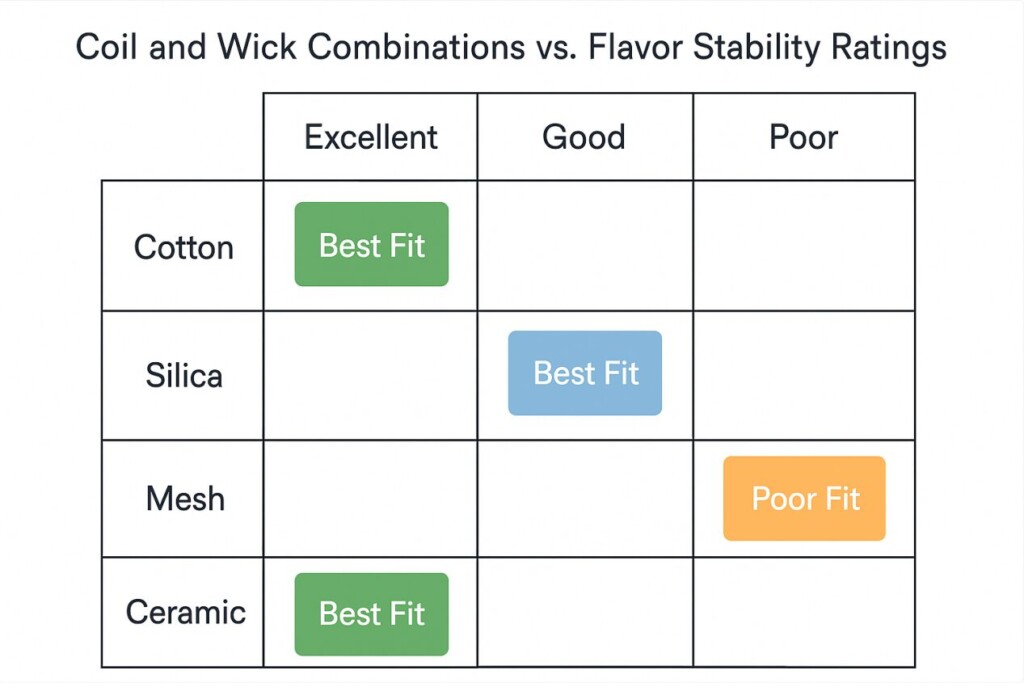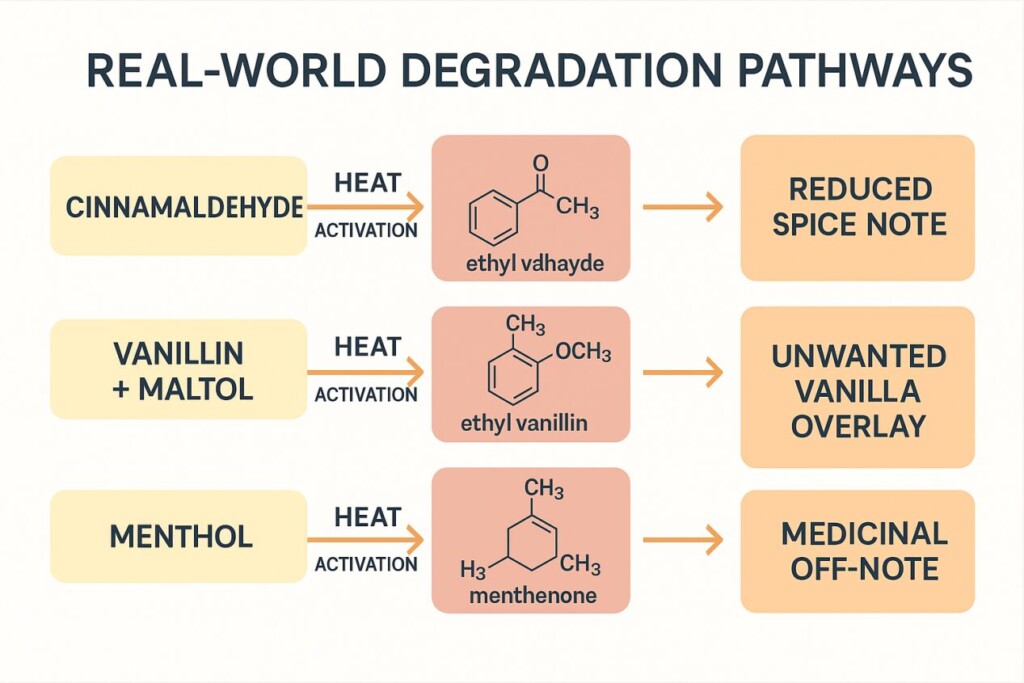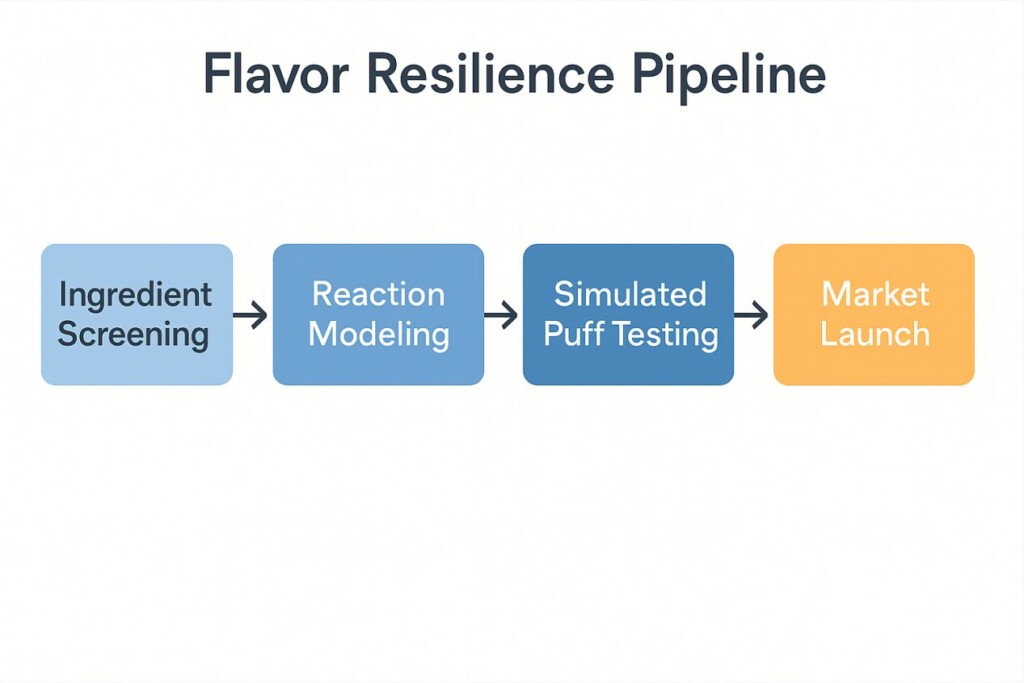
You’ve sourced premium flavor compounds. You’ve perfected your formulation ratios. You’ve conducted sensory tests that wowed your in-house team. And yet — your final product doesn’t deliver consistent flavor after a few puffs, especially on high-powered devices. Why?
The issue often lies beyond taste preference or ingredient quality. It’s about what happens after ignition — when those carefully selected molecules face thermal stress. This post dives into the invisible yet critical problem of thermal degradation and cross-reactions in e-liquid flavor formulation. For e-liquid manufacturers, R&D chemists, and procurement specialists, understanding this phenomenon is essential for consistent quality and market success.
Modern vaping hardware operates in an environment where the temperatures can fluctuate rapidly and significantly — often from room temperature to over 250°C in mere seconds. These extreme shifts can cause significant chemical transformations. Flavor degradation, unwanted chemical byproducts, and reduced sensory fidelity are common — and often misunderstood — outcomes.
E-liquid compounds are formulated for stability and flavor balance — but not all are built to withstand the temperatures generated during vaping. A standard sub-ohm coil may reach 200°C to 250°C within seconds, exposing flavor molecules to rapid and sometimes irreversible breakdown.
Among the most thermally sensitive classes:
Esters (e.g., ethyl butyrate, isoamyl acetate): These compounds are typically responsible for fruity and sweet notes but are extremely heat-sensitive. They decompose into alcohols and acids, which can sour the flavor.
Aldehydes (e.g., cinnamaldehyde, vanillin): Known for warm and spicy profiles. They are prone to oxidation, transforming into acids or forming reactive intermediates.
Ketones and lactones: Used for creamy or buttery tones. At high temperatures, they may undergo ring-opening or participate in rearrangement reactions, altering their flavor contribution.
Pyrolysis: Breakdown of organic materials at high heat leads to fragments like alkenes, alkynes, or carbonyls.
Oxidation: Interaction with oxygen results in peroxides, aldehydes, and acids.
Radical Reactions: Free radicals generated at high heat can trigger uncontrolled chain reactions.
Maillard-like reactions: Though more common in food chemistry, complex browning-like reactions can also occur, especially when sugars or nitrogenous compounds are present.
Understanding the thermal limitations of each compound can help predict and mitigate unwanted reactions before they become a product liability.
Cross-reactions occur when flavor molecules that are stable on their own become unstable in combination under heat. Some interactions are beneficial; others are disastrous. Here are several categories:
Aldehydes like vanillin or benzaldehyde can react with amines or nitrogen-containing compounds, forming Schiff bases — imines that are often bitter or pungent.
High heat accelerates the esterification of acids and alcohols within the formulation, potentially generating new esters. While this may sound pleasant, unanticipated ester formation can drastically shift the flavor profile and intensity.
Compounds like furans or pyrazines can rearrange into molecules with entirely different olfactory properties, leading to smokiness, bitterness, or earthy off-notes.
Example 1: Vanillin + Acetyl Pyrazine
Once a rich bakery combination, at high temperatures they form reactive complexes that cause acrid, metallic backnotes.
Example 2: Menthol + Citral
This cooling-lemon blend seems refreshing until degradation products yield citral oxide derivatives, which are both harsh and irritant.
Example 3: Sucralose + Fruity Esters
Sucralose begins degrading at 120°C, producing chloropropanols and possibly toxic furan derivatives.
Many e-liquid brands focus solely on shelf-life stability — monitoring for changes in color, separation, or microbial contamination over time. However, thermal stability during actual use is often overlooked.
Simulate vaping behavior using temperature-controlled setups. Alternate between rest (room temperature) and active use (~200–250°C) for 100–200 cycles.
Compare unvaporized and vaporized samples to identify degradation products that may not be detectable in the liquid phase.
Especially relevant for citrus and acidic profiles. Thermal changes may alter the dissociation of acidic molecules, leading to harsh throat hits or burnt notes.
Use industry-standard devices or custom-built chambers to replicate consumer usage conditions. Include variability in puff duration, wattage, and air intake.
Laboratory testing under realistic use conditions is the only way to anticipate and prevent thermal failures.
Create a screening protocol for all new flavor compounds:
Request thermal decomposition curves from suppliers
Run small-scale degradation trials at 150°C, 200°C, and 250°C
Use thermogravimetric analysis (TGA) for weight loss profiling under heat
Terpenoids like linalool or menthol are relatively stable below 200°C
Ketals and acetals may be more resistant to hydrolysis under certain pH conditions
Encapsulation in carriers such as cyclodextrins, spray-dried maltodextrin, or liposomal emulsions can shield sensitive volatiles. This not only improves heat resistance but also reduces flavor bleed in multi-compartment tanks.
Use non-ionic emulsifiers with high thermal thresholds (e.g., polysorbate 80, lecithin variants) to stabilize flavor distribution, especially in high-VG blends.
For flavor formulations specifically engineered for high thermal stability in e-liquid applications, Guangdong Unique Flavor Co., Ltd. offers the “CUIGUAI” line — tested under advanced thermal cycling models with proven results in high-wattage vape systems.
This line is particularly useful for dessert, tobacco, and fruit blends used in pod and sub-ohm platforms.
Each device type interacts differently with flavor compounds. Key coil materials include:
Kanthal (FeCrAl): Consistent heat profile; good for robust flavor blends.
Stainless Steel (SS316L): Rapid heat-up and cooldown, suitable for volatile-sensitive formulations.
Nickel (Ni200): Temperature control enabled; requires precise formulation.
Ceramic: Extended surface contact, may encourage longer-lasting but also more degrading vapor contact.
Organic cotton: Standard material; may trap oils or oxidize under prolonged exposure.
Silica: Heat-resistant but may impact flavor clarity.
Ceramic-coated cotton: Improves thermal dispersion but may retain flavors, affecting blend switching.
Design your flavor output curve to match target devices. Higher wattage should correspond with more thermally robust flavor blends, while lower wattage can use more volatile, delicate aromatics.
An initially well-received pineapple–guava e-liquid started receiving poor reviews after 3 weeks. Analytical review showed ester breakdown into short-chain acids and alcohols, exacerbated by a poor emulsifier choice.
A dessert-tobacco blend turned metallic after extended use in ceramic coils. GC-MS revealed cross-reactions between vanillin and pyrazine, forming quinoxalines and aldehydic residues.
A lime-mint profile was reported to fade within 5 puffs on sub-ohm devices. Menthol degraded into menthone and carvacrol, while citral oxidized, reducing flavor freshness and increasing throat harshness.
A popular strawberry–cream blend developed off-smells in pod systems. Root cause was sucralose degradation into chlorinated byproducts at 160°C, reacting further with lactic esters.
These failures underscore the importance of comprehensive testing and thermally aware formulation from the earliest R&D phase.
Flavor failure isn’t always due to poor raw materials. It’s often the result of thermally incompatible combinations, untested reactions, or overlooked coil-device interactions. A new paradigm for flavor development in vaping must center on thermal chemistry awareness.
Build a vetted flavor compound database with heat-tolerance metrics
Conduct vapor-phase testing, not just liquid-phase aging
Segment flavor lines by device wattage and temperature class
Screen for common cross-reaction risks in flavor combinations
Choose suppliers with demonstrated thermal research and encapsulation technologies
Perform full thermal simulation tests across realistic usage conditions
With the growth of sub-ohm, temperature-controlled, and high-wattage devices, the need for thermochemically optimized flavors is no longer optional — it is fundamental to product success.
Keywords:
thermal degradation in vape flavors, e-liquid cross-reactions, vape juice flavor stability, GC-MS vape analysis, stable e-liquid formulation, flavor encapsulation for vaping, Guangdong Unique Flavor, CUIGUAI
Blog post produced by CUIGUAI Flavoring
The business scope includes licensed projects: food additive production. General projects: sales of food additives; manufacturing of daily chemical products; sales of daily chemical products; technical services, technology development, technical consultation, technology exchange, technology transfer, and technology promotion; biological feed research and development; industrial enzyme preparation research and development; cosmetics wholesale; domestic trading agency; sales of sanitary products and disposable medical supplies; retail of kitchenware, sanitary ware and daily sundries; sales of daily necessities; food sales (only sales of pre-packaged food).
Copyright ©Guangdong Unique Flavor Co., Ltd.All Rights Reserved. Privacy Policy